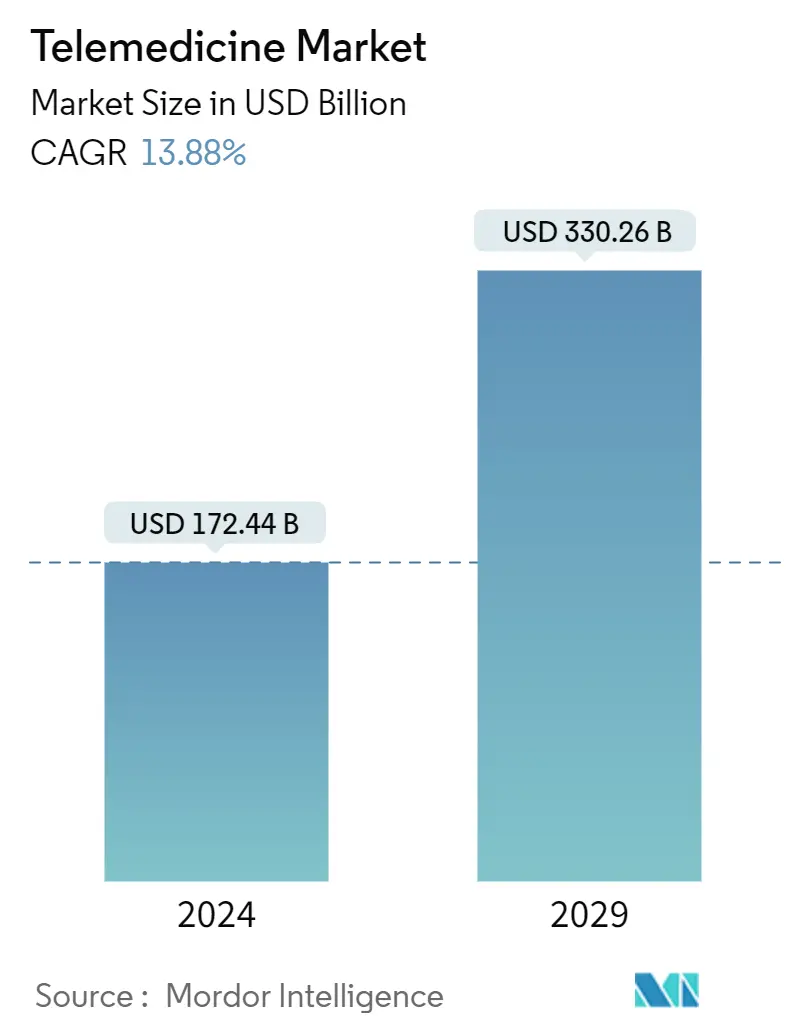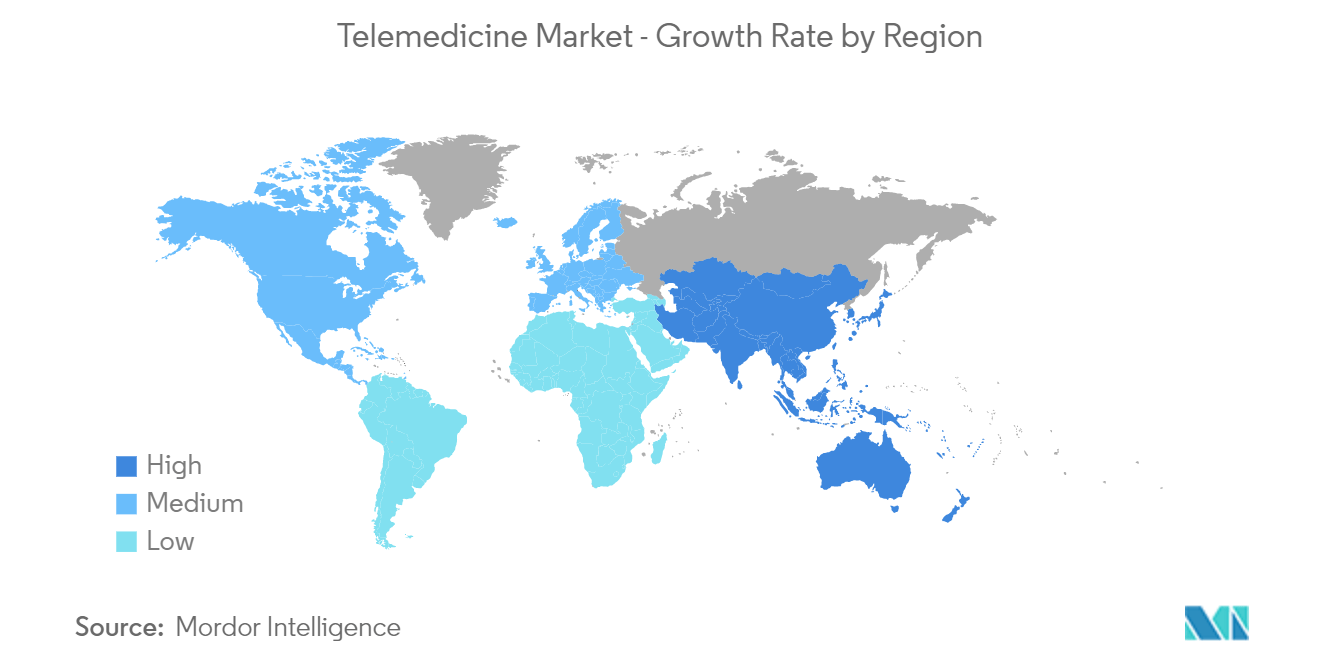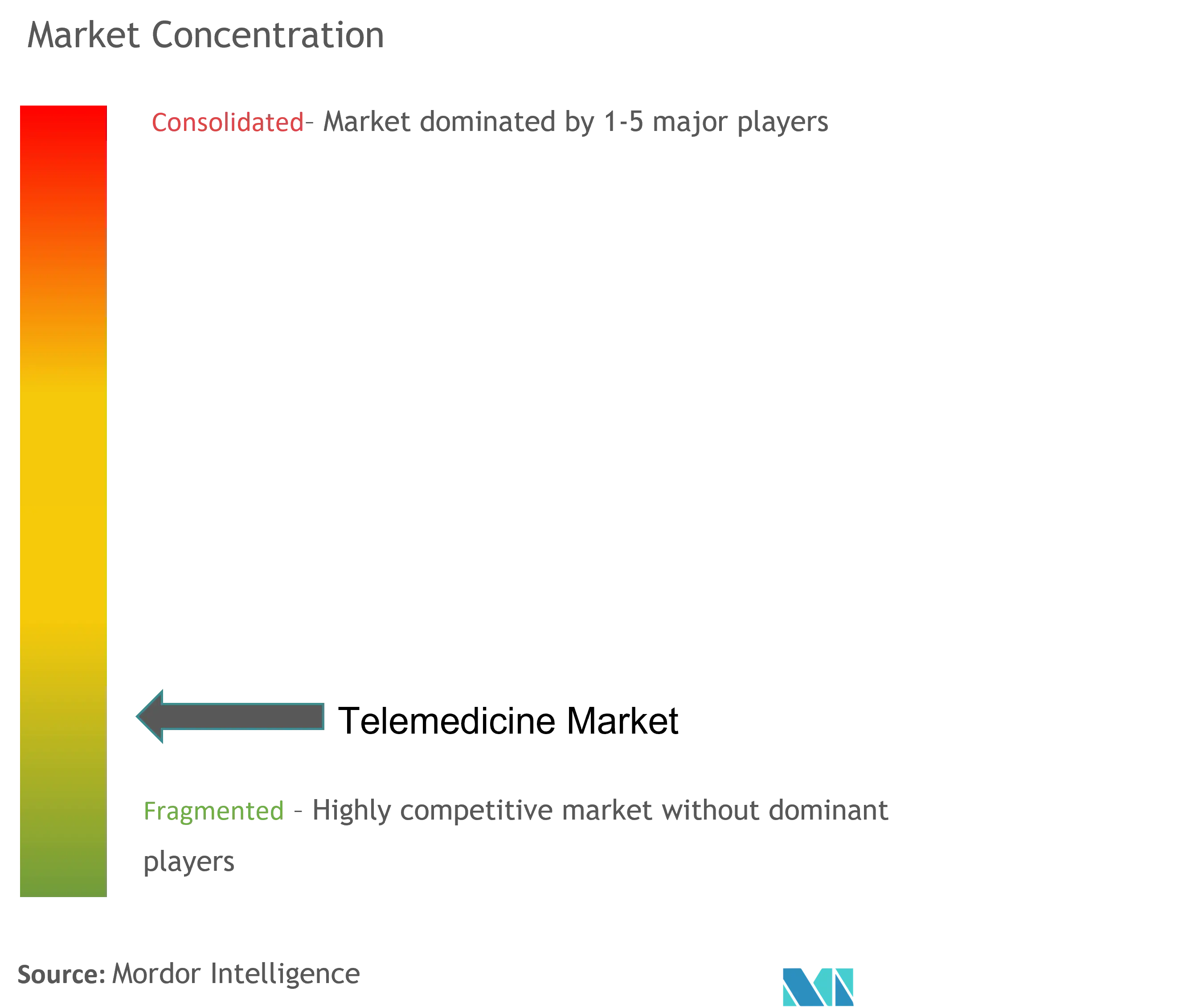Telemedicine Market Size

| Study Period | 2021 - 2029 |
| Market Size (2024) | USD 172.44 Billion |
| Market Size (2029) | USD 330.26 Billion |
| CAGR (2024 - 2029) | 13.88 % |
| Fastest Growing Market | Asia-Pacific |
| Largest Market | North America |
Major Players
*Disclaimer: Major Players sorted in no particular order |
Telemedicine Market Analysis
The Telemedicine Market size is estimated at USD 172.44 billion in 2024, and is expected to reach USD 330.26 billion by 2029, growing at a CAGR of 13.88% during the forecast period (2024-2029).
The telemedicine industry has emerged in the healthcare sector during the COVID-19 pandemic. Though telemedicine services were integrated into most healthcare systems even before the onset of the pandemic, services began to be extensively used only during the COVID-19 crisis. An article published in October 2021, by Foundation for Research and Technology Greece, explained that during the pandemic, COVID-19 served as a catalyst and accelerator for telehealth market growth. Regulators worked to eliminate data silos in artificial intelligence and digital health to better promote innovation. Furthermore, the United States has approved legislation to allow for more seamless data flow, while the European Union integrated the data across member states to permit the interchange of electronic health records (EHRs) across borders during the pandemic. Additionally, according to a study published in Health Affairs, in September 2022, during the COVID-19 pandemic, a small percentage of primary care doctors were responsible for the more than 4-fold rise in the usage of remote patient monitoring (RPM). As per telehealth statistics, digital health solutions have demonstrated the ability to enhance health outcomes during a high-stress period like the COVID-19 pandemic and being integrated with conventional healthcare services which are expected to further increase the demand for telemedicine industry.
The major factors for the growth of the telehealth market include rising healthcare expenditure, technological innovations and rising demand for remote patient monitoring, and the growing burden of chronic diseases. For instance, according to the UK Health Accounts provisional estimates, the 2021 report, published in May 2022, the total current healthcare expenditure in 2021 was estimated at GBP 277 billion (USD 317 billion), which is an increase in nominal terms of 7.4% on spending in 2020. Furthermore, as per the 2022 update from the Canadian Institute for Health Information, hospitals (24.34%), physicians (13.60%), and drugs (13.58%) categories continued to account for the largest shares, which is over half of the total health spending in 2022. As the cost of in-person consultation is much higher than online consultation and is more tedious, telehealth services are more advantageous for customers. This is likely to boost the growth of the telehealth market over the forecast period.
Furthermore, according to CDC, in 2021, around 18.2 million adults aged 20 and older had coronary artery disease (CAD) in the United States. Heart disease is the leading cause of death in the United States. Also, as per the 2022 update from the International Diabetic Federation (IDF), approximately 537 million adults (20-79 years) are living with diabetes. The total number of people living with diabetes is projected to rise to 643 million by 2030 and 783 million by 2045. The high incidence of chronic diseases increases the demand for huge telemedicine, which, in turn, drives the telemedicine market size.
Thus, the abovementioned factors are impacting the telemedicine market growth. However, legal and reimbursement issues and high initial capital requirements, and lack of physician support are expected to hinder the telemedicine industry growth over the forecast period.
Telemedicine Market Trends
Tele homes Segment is Expected to Witness a Significant Growth Over the Forecast Period
Tele homes involve delivering healthcare services to clients in their own homes. The rise of chronic diseases is a global concern that strains healthcare resources. Tele home services include innovative ways to provide care, monitor a patient, and provide information using the latest technology. Monitoring allows early identification of diseases and provides aid in emergencies. Hence, the use of tele home services is increasing. For instance, according to an article published by JMIR Publications, in January 2022, children and their families chose pediatric tele home care since it is 9% less expensive than traditional hospital care, freeing up hospital beds for more complicated situations in Spain.
Further, people prefer tele home at home rather than visiting a hospital for treatment owing to greater convenience and reduction in overall cost. For instance, according to an article published by the Partnership for Quality Home Healthcare, in 2021, some 86% of adults preferred to receive "post-hospital, short-term healthcare" at home, while only 5% preferred nursing homes in the United States. Tele home services provide an opportunity for significant savings for patients and hospitals. Thus, the increasing adoption rate of tele homes services is directly affecting the telehealth market growth. Therefore, factors such increase adoption rate and low cost of tele home are expected to drive segmental growth in the telemedicine market during the forecast period.

North America is Expected to Dominate the Telemedicine Market Over the Forecast Period
Telemedicine market share is a rapidly growing in the United States’ healthcare sector due to the growing burden of chronic diseases and the high adoption of advanced healthcare technologies. The adoption of telemedicine has improved care management, patients' quality of life, and reduced healthcare spending. Furthermore, the rising demand for mobile technologies, rising home care adoption by patients, increased healthcare expenditure, and reduction in hospital visits are expected to propel the telemedicine market size over the forecast period. For instance, according to the 2021 report from the Canadian Institute of Health Information, Canadian health expenditure increased to USD 308.1 billion in 2021 compared to USD 301.5 billion in 2020. Similarly, as per the 2022 report of the Centers for Medicare and Medicaid Services (CMS), the health expenditure of the United States was about USD 4.3 trillion, an increase of about USD 173 billion from the previous year. Thus, the increasing healthcare spending is anticipated to create opportunities for telehealth, thereby propelling the market growth.
Additionally, the largest telehealth companies are engaged in partnerships, collaborations, acquisitions, mergers, and product launches to innovate in the telemedicine market, driving growth in the forecast period. For instance, in April 2021, Inova Health System in the Northern Virginia and Washington DC area, United States, offered an FDA-approved telemedicine option for remote neuromodulation of deep brain stimulation (DBS) patients being treated for Parkinson's disease and essential tremor. Also, in August 2022, Hicuity Health launched tele-ICU services at MUSC Health Columbia Medical Center Downtown in Columbia, South Carolina. Therefore, such development is expected to drive the telemedicine market. Thus, given the factors above, the telemedicine market is expected to grow significantly in North America over the forecast period.

Telemedicine Industry Overview
The telemedicine market is fragmented in nature due to the presence of several companies operating globally as well as regionally. The competitive landscape includes an analysis of a few international telemedicine companies as well as local companies which hold market shares and are well known including Allscripts Healthcare Solutions Inc., BioTelemetry, Medtronic, Koninklijke Philips NV, Aerotel Medical Systems (1998) Ltd, AMD Global Telemedicine Inc., and SOC Telemed, among others.
Telemedicine Market Leaders
-
AMD Global Telemedicine Inc.
-
Resideo Technologies Inc. (Honeywell Life Care Solutions)
-
Allscripts Healthcare Solutions Inc.
-
Koninklijke Philips NV
-
Aerotel Medical Systems
*Disclaimer: Major Players sorted in no particular order

Telemedicine Market News
- August 2022: Hicuity Health launched tele-ICU services at MUSC Health Columbia Medical Center Downtown in Columbia, South Carolina. The new service launch draws upon MUSC Health's long-standing collaboration with Hicuity Health which delivers telemedicine services to hospitals across the state.
- April 2022: Bayer launched 27 telemedicine centers in 12 districts across eight states in India over the next two years through Bayer Foundation India.
Telemedicine Market Report - Table of Contents
1. INTRODUCTION
- 1.1 Study Assumptions and Market Definition
- 1.2 Scope of the Study
2. RESEARCH METHODOLOGY
3. EXECUTIVE SUMMARY
4. MARKET DYNAMICS
- 4.1 Market Overview
-
4.2 Market Drivers
- 4.2.1 Rising Healthcare Expenditure
- 4.2.2 Technological Innovations and Rising Demand for Remote Patient Monitoring
- 4.2.3 Growing Burden of Chronic Diseases
-
4.3 Market Restraints
- 4.3.1 Legal and Reimbursement Issues
- 4.3.2 High Initial Capital Requirements and Lack of Physician Support
-
4.4 Porter's Five Forces Analysis
- 4.4.1 Threat of New Entrants
- 4.4.2 Bargaining Power of Buyers/Consumers
- 4.4.3 Bargaining Power of Suppliers
- 4.4.4 Threat of Substitute Products
- 4.4.5 Intensity of Competitive Rivalry
5. MARKET SEGMENTATION (Market Size by Value)
-
5.1 By Type
- 5.1.1 Tele hospitals
- 5.1.2 Tele homes
- 5.1.3 mHealth (Mobile Health)
-
5.2 By Component
- 5.2.1 Products
- 5.2.1.1 Hardware
- 5.2.1.2 Software
- 5.2.1.3 Other Products
- 5.2.2 Services
- 5.2.2.1 Telepathology
- 5.2.2.2 Telecardiology
- 5.2.2.3 Teleradiology
- 5.2.2.4 Teledermatology
- 5.2.2.5 Telepsychiatry
- 5.2.2.6 Other Services
-
5.3 By Mode of Delivery
- 5.3.1 On-premise Delivery
- 5.3.2 Cloud-based Delivery
-
5.4 Geography
- 5.4.1 North America
- 5.4.1.1 US
- 5.4.1.2 Canada
- 5.4.1.3 Mexico
- 5.4.2 Europe
- 5.4.2.1 Germany
- 5.4.2.2 UK
- 5.4.2.3 France
- 5.4.2.4 Italy
- 5.4.2.5 Spain
- 5.4.2.6 Rest of Europe
- 5.4.3 Asia-Pacific
- 5.4.3.1 China
- 5.4.3.2 Japan
- 5.4.3.3 India
- 5.4.3.4 Australia
- 5.4.3.5 South Korea
- 5.4.3.6 Rest of Asia-Pacific
- 5.4.4 Middle East and Africa
- 5.4.4.1 GCC
- 5.4.4.2 South Africa
- 5.4.4.3 Rest of Middle East and Africa
- 5.4.5 South America
- 5.4.5.1 Brazil
- 5.4.5.2 Argentina
- 5.4.5.3 Rest of South America
6. COMPETITIVE LANDSCAPE
-
6.1 Company Profiles
- 6.1.1 Aerotel Medical Systems (1998) Ltd
- 6.1.2 IBM
- 6.1.3 Allscripts Healthcare Solutions Inc.
- 6.1.4 AMD Global Telemedicine Inc.
- 6.1.5 SOC Telemed
- 6.1.6 Resideo Technologies Inc.
- 6.1.7 Koninklijke Philips NV
- 6.1.8 Medtronic PLC
- 6.1.9 SHL Telemedicine
- 6.1.10 Teladoc Health Inc. (InTouch Technologies Inc.)
- 6.1.11 Cerner Corporation
- 6.1.12 Cisco System
- *List Not Exhaustive
7. MARKET OPPORTUNITIES AND FUTURE TRENDS
** Subject To AvailablityTelemedicine Industry Segmentation
As per the scope of this report, telehealth is the remote delivery of healthcare services, such as consultations over telecommunication or teleconference, and it allows healthcare professionals to evaluate, diagnose, and treat patients. The Telemedicine Market is segmented By Type (Tele hospitals, Tele homes, and mHealth), Component (Products and Services), Mode of Delivery (On-premises Delivery and Cloud-based Delivery), and Geography (North America, Europe, Asia-Pacific, Middle East and Africa, and South America). The market report also covers the estimated telemedicine market sizes and trends for 17 different countries across major regions, globally. The report offers the value (in USD million) for the above segments.
| By Type | Tele hospitals | |
| Tele homes | ||
| mHealth (Mobile Health) | ||
| By Component | Products | Hardware |
| Software | ||
| Other Products | ||
| By Component | Services | Telepathology |
| Telecardiology | ||
| Teleradiology | ||
| Teledermatology | ||
| Telepsychiatry | ||
| Other Services | ||
| By Mode of Delivery | On-premise Delivery | |
| Cloud-based Delivery | ||
| Geography | North America | US |
| Canada | ||
| Mexico | ||
| Geography | Europe | Germany |
| UK | ||
| France | ||
| Italy | ||
| Spain | ||
| Rest of Europe | ||
| Geography | Asia-Pacific | China |
| Japan | ||
| India | ||
| Australia | ||
| South Korea | ||
| Rest of Asia-Pacific | ||
| Geography | Middle East and Africa | GCC |
| South Africa | ||
| Rest of Middle East and Africa | ||
| Geography | South America | Brazil |
| Argentina | ||
| Rest of South America |
Telemedicine Market Research FAQs
How big is the Telemedicine Market?
The Telemedicine Market size is expected to reach USD 172.44 billion in 2024 and grow at a CAGR of 13.88% to reach USD 330.26 billion by 2029.
What is the current Telemedicine Market size?
In 2024, the Telemedicine Market size is expected to reach USD 172.44 billion.
Who are the key players in Telemedicine Market?
AMD Global Telemedicine Inc., Resideo Technologies Inc. (Honeywell Life Care Solutions), Allscripts Healthcare Solutions Inc., Koninklijke Philips NV and Aerotel Medical Systems are the major companies operating in the Telemedicine Market.
Which is the fastest growing region in Telemedicine Market?
Asia-Pacific is estimated to grow at the highest CAGR over the forecast period (2024-2029).
Which region has the biggest share in Telemedicine Market?
In 2024, the North America accounts for the largest market share in Telemedicine Market.
What years does this Telemedicine Market cover, and what was the market size in 2023?
In 2023, the Telemedicine Market size was estimated at USD 148.51 billion. The report covers the Telemedicine Market historical market size for years: 2021, 2022 and 2023. The report also forecasts the Telemedicine Market size for years: 2024, 2025, 2026, 2027, 2028 and 2029.
What are the segments of the Telemedicine Market?
The segments of the Telemedicine Market are a) Type: Tele hospitals, Tele homes, and mHealth, Component Products and Services b) Mode of Delivery: On-premises Delivery and Cloud-based Delivery
What are the applications of telemedicine in healthcare?
The applications of telemedicine in healthcare include Telepsychiatry, Tele dermatology, Teleradiology, Telecardiology and mHealth.
Telemedicine Industry Report
The Global Telemedicine Market is segmented by type, component, mode of delivery, and geography, offering a comprehensive industry analysis. The market overview reveals that the telemedicine market size is expanding, driven by increasing demand for teleconsultation, telemonitoring, and tele-education/training services. The industry growth is propelled by advancements in tele-ICU and telestroke applications, which are becoming integral parts of the healthcare system.
The industry outlook is positive, with market leaders investing in innovative solutions to enhance tele-home and mHealth services. The market segmentation includes various end-users such as providers, payers, and patients, each contributing to the market's growth rate. The market forecast indicates a steady rise in market value, supported by the adoption of cloud-based delivery models.
Industry information highlights that North America, Europe, Asia-Pacific, the Middle East, Africa, and South America are key regions driving market trends. The market data suggests that the real-time modality is gaining traction, further boosting the market growth. The industry statistics underline the significance of on-premises delivery in certain segments.
Market research reports provide detailed insights into market predictions and market review, helping stakeholders understand the market dynamics. The industry size is expected to grow, with market leaders focusing on expanding their market share. Market segmentation by products and services offers a clear picture of the market landscape.
Industry reports and market analysis reveal that the telemedicine market is poised for significant growth, with market outlook remaining optimistic. The market forecast and market predictions are based on comprehensive research, ensuring accurate market data. The industry trends indicate a shift towards more integrated and efficient telemedicine solutions.
In conclusion, the telemedicine market is set for robust growth, with industry research and market review pointing towards a promising future. The market value is expected to increase, driven by continuous innovations and the adoption of advanced technologies. The report pdf provides a detailed analysis of the market, offering valuable insights for research companies and stakeholders.



